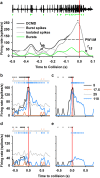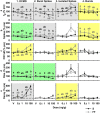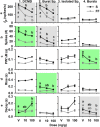A sublethal dose of a neonicotinoid insecticide disrupts visual processing and collision avoidance behaviour in Locusta migratoria
- PMID: 28428563
- PMCID: PMC5430526
- DOI: 10.1038/s41598-017-01039-1
A sublethal dose of a neonicotinoid insecticide disrupts visual processing and collision avoidance behaviour in Locusta migratoria
Abstract
Neonicotinoids are known to affect insect navigation and vision, however the mechanisms of these effects are not fully understood. A visual motion sensitive neuron in the locust, the Descending Contralateral Movement Detector (DCMD), integrates visual information and is involved in eliciting escape behaviours. The DCMD receives coded input from the compound eyes and monosynaptically excites motorneurons involved in flight and jumping. We show that imidacloprid (IMD) impairs neural responses to visual stimuli at sublethal concentrations, and these effects are sustained two and twenty-four hours after treatment. Most significantly, IMD disrupted bursting, a coding property important for motion detection. Specifically, IMD reduced the DCMD peak firing rate within bursts at ecologically relevant doses of 10 ng/g (ng IMD per g locust body weight). Effects on DCMD firing translate to deficits in collision avoidance behaviours: exposure to 10 ng/g IMD attenuates escape manoeuvers while 100 ng/g IMD prevents the ability to fly and walk. We show that, at ecologically-relevant doses, IMD causes significant and lasting impairment of an important pathway involved with visual sensory coding and escape behaviours. These results show, for the first time, that a neonicotinoid pesticide directly impairs an important, taxonomically conserved, motion-sensitive visual network.
Conflict of interest statement
The authors declare that they have no competing interests.
Figures








Similar articles
-
Neonicotinoid and sulfoximine pesticides differentially impair insect escape behavior and motion detection.Proc Natl Acad Sci U S A. 2020 Mar 10;117(10):5510-5515. doi: 10.1073/pnas.1916432117. Epub 2020 Feb 24. Proc Natl Acad Sci U S A. 2020. PMID: 32094166 Free PMC article.
-
Neural conduction, visual motion detection, and insect flight behaviour are disrupted by low doses of imidacloprid and its metabolites.Neurotoxicology. 2019 May;72:107-113. doi: 10.1016/j.neuro.2019.02.012. Epub 2019 Feb 18. Neurotoxicology. 2019. PMID: 30790592
-
Spatiotemporal stimulus properties modulate responses to trajectory changes in a locust looming-sensitive pathway.J Neurophysiol. 2014 May;111(9):1736-45. doi: 10.1152/jn.00499.2013. Epub 2014 Jan 29. J Neurophysiol. 2014. PMID: 24478154
-
A pair of motion-sensitive neurons in the locust encode approaches of a looming object.J Comp Physiol A Neuroethol Sens Neural Behav Physiol. 2010 Dec;196(12):927-38. doi: 10.1007/s00359-010-0576-7. Epub 2010 Sep 9. J Comp Physiol A Neuroethol Sens Neural Behav Physiol. 2010. PMID: 20827481
-
Background visual motion affects responses of an insect motion-sensitive neuron to objects deviating from a collision course.Physiol Rep. 2016 May;4(10):e12801. doi: 10.14814/phy2.12801. Physiol Rep. 2016. PMID: 27207786 Free PMC article.
Cited by
-
Acute Application of Imidacloprid Alters the Sensitivity of Direction Selective Motion Detecting Neurons in an Insect Pollinator.Front Physiol. 2021 Jul 8;12:682489. doi: 10.3389/fphys.2021.682489. eCollection 2021. Front Physiol. 2021. PMID: 34305640 Free PMC article.
-
Extremely low neonicotinoid doses alter navigation of pest insects along pheromone plumes.Sci Rep. 2019 May 31;9(1):8150. doi: 10.1038/s41598-019-44581-w. Sci Rep. 2019. PMID: 31148562 Free PMC article.
-
Sublethal insecticide exposure of larvae affects the blood-feeding behaviour of adult mosquitoes.Parasit Vectors. 2025 May 24;18(1):189. doi: 10.1186/s13071-025-06815-x. Parasit Vectors. 2025. PMID: 40413486 Free PMC article.
-
Neonicotinoid and sulfoximine pesticides differentially impair insect escape behavior and motion detection.Proc Natl Acad Sci U S A. 2020 Mar 10;117(10):5510-5515. doi: 10.1073/pnas.1916432117. Epub 2020 Feb 24. Proc Natl Acad Sci U S A. 2020. PMID: 32094166 Free PMC article.
-
A neonicotinoid pesticide alters Drosophila olfactory processing.Sci Rep. 2023 Jun 30;13(1):10606. doi: 10.1038/s41598-023-37589-w. Sci Rep. 2023. PMID: 37391495 Free PMC article.
References
Publication types
MeSH terms
Substances
LinkOut - more resources
Full Text Sources
Other Literature Sources

